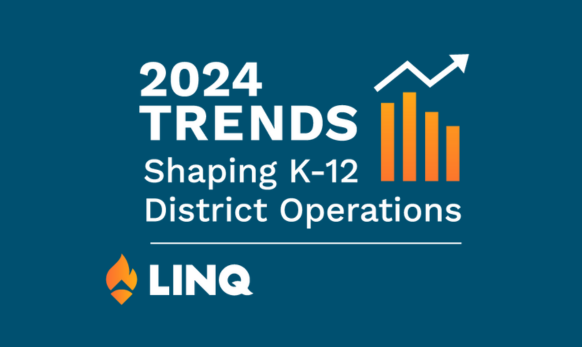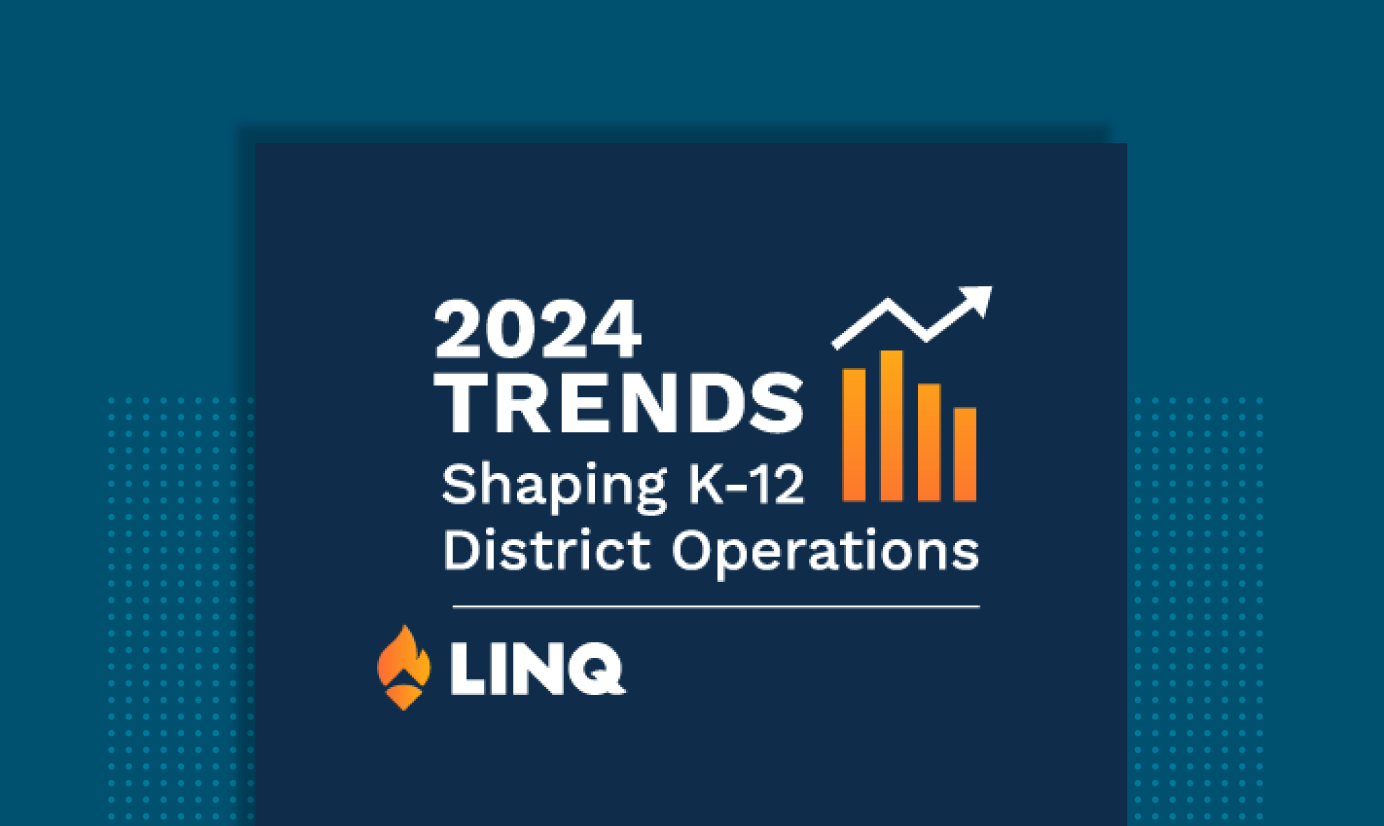In the dynamic landscape of K-12 education, 2024 brings several distinct challenges that will shape the management of district operations. From persistent staffing shortages to heightened K-12 cybersecurity threats to tighter budgets resulting from the end of ESSER III funding, the need to adapt with operational agility is more important than ever.
In this blog, we’ll take a closer look at the most top-of-mind operational priorities for K-12 district leaders in the year ahead. As we examine each trend, we’ll explore practical ideas for navigating the biggest challenges.
Be sure to join our companion webinar series featuring conversations with K-12 experts about each trend and live Q&A sessions to discuss your most pressing issues.
Trend #1: Staffing and retention are still tough
More than eight in ten schools are experiencing challenges filling open positions, according to the National Center for Education Statistics (NCES). Not strictly limited to teacher shortages, difficulties filling non-teaching positions continue to take a toll on central offices. When releasing this data in October 2023, NCES Commissioner Peggy C. Hall added, “The majority of public schools are experiencing staffing challenges at the same levels they did last school year.” According to SNA’s 2024 School Nutrition Trends Report, 90.5% of nutrition directors report challenges with staffing shortages. It’s an ongoing trend that’s only becoming more urgent to find solutions.
Hiring challenges put additional pressure on districts to retain the employees they already have—especially considering the high cost of turnover in a year with even tighter budgets. According to the most recent NCES School Pulse Panel study in October, about 45% of public schools report still having at least one non-teaching staff vacancy. As district and school personnel are pulled in to cover the extra work, it places additional stress on retaining existing staff.
What can districts do?
When it comes to hiring, qualified applicants have many choices in the current job market, making it harder for districts to compete for those candidates. Providing an efficient, flexible onboarding experience provides a better, faster way to set new employees up for success and earn a reputation as a great place to work.
For example, digital onboarding packets and forms with a system like LINQ Forms & Workflows give new hires the flexibility to complete most of the process from anywhere, on their own schedule. By expediting the “paperwork” process, new hires can more quickly focus their time on learning the ropes of their new position.
A strong onboarding process can impact retention, as well. Research from Brandon Hall Group shows a strong onboarding program can improve new hire retention by 82%. Establishing a culture of support, communication, and mentorship helps employees feel a sense of belonging, creating stronger engagement and longer-term commitment.
Trend #2: Costs keep rising as budgets get tighter
2024 brings a heightened state of uncertainty amidst rising costs and shrinking budgets. Declining enrollment, supply chain disruptions, and rising labor costs are exacerbating existing concerns about the ESSER funding cliff and tighter state budgets.
57% of respondents in our 2023 K-12 Nutrition Survey Report pointed to rising costs as their top concern. According to Consumer Price Index (CPI) data from the U.S. Bureau of Labor Statistics, School food prices increased by 296% from April 2022 to April 2023. SNA’s 2024 School Nutrition Trends Report indicates that districts with the highest levels of free-and-reduced meal eligibility have been especially hard hit by procurement challenges such as menu item shortages, late/delayed deliveries, canceled contracts, and longer lead times.
At this rate, 44.6% of K-12 nutrition directors have a “serious concern” about the financial sustainability of their nutrition programs three years from now, according to SNA’s report.
On top of rising costs, 2024 will also see budgets tighten as federal stimulus funds come to an end. While the impact on districts will vary based on the level of ESSER funds received, the Brookings Institution reports the “fiscal cliff” equates to “a single-year reduction in spending of over $1,000 per student”, on average.
What can districts do?
While school nutrition programs may feel the impacts of current operational cost increases most, every department benefits by improving efficiency to reduce waste, stretch budgets, and do more with available resources. Gaps in processes and information sharing can quickly add up to wasted money due to incorrect ordering, forgotten inventory, and expired perishables. That’s where technology can play a big role.
Digital platforms, like a complete K-12 ERP system or an integrated front of house (FOH) and back of house (BOH) nutrition solution, can automate processes, close information gaps, improve decision-making, and thus reduce inefficiencies and waste. Digitizing processes can also help to eliminate paper usage—potentially saving millions of dollars per year for larger districts still relying heavily on manual, paper-based processes.
Trend #3: Cybersecurity threats continue to rise in K-12
Ransomware attacks alone cost U.S. school districts an estimated $35.1 billion in downtime between 2018 and 2023. Cybersecurity firm SonicWall reported a 275% rise in ransomware attacks on K-12 targets in 2023. From ransomware and malware attacks to phishing and DDoS, cyberattacks, on the whole, are still rising.
School systems hold an abundance of valuable data. Yet their cybersecurity often is not resourced to the level of other industries. That’s why a single cybersecurity breach could cost millions of dollars in operational disruptions and ransoms, in addition to putting the personal data of students, staff, and family at risk. Recent National Cybersecurity Review (NCSR) survey results reveal that K-12 schools allocate an average of 8% or less of their IT budget for cybersecurity. Additionally, over one-third of respondents did not have an incident response plan in place. With so much at risk, it’s clear why cybersecurity needs will likely drive action in 2024.
What can districts do?
Putting more focus on cybersecurity is no longer an option for districts looking to reduce the risk of an attack. That starts with including IT leadership in every major technology decision and prioritizing resourcing essential security measures in future budgets. Basic cybersecurity protections like implementing multi-factor authentication (MFA) and role-specific authorization can make a significant impact, especially if these features are already available within your current technology solutions.
LINQ Chief Information Security Officer Tim Chadwick advises districts to first speak with their technology providers about improving cybersecurity. “There may already be cybersecurity tools within your current products you could quickly implement,” he says. For additional protection, outsourcing more advanced support may be necessary. “It’s actually very cost-effective in most cases to hire a cybersecurity firm for measures like staff training and response planning,” he says, “especially when you consider the potential cost of a data breach.” Tim will share more of his tips in our upcoming webinar focused on 2024 cybersecurity.
Trend #4: Future readiness depends on adaptability and resiliency
Even with the disruptions caused by the pandemic behind us, K-12 leaders tell us they still see plenty of changes on the horizon. In addition to the end of ESSER III funding in September, pending USDA meal pattern changes to milk, sugar, whole grains, and sodium could begin taking effect in the upcoming 2024-25 school year. Along with the uncertainty come expectations that prices will continue to rise, budgets will get squeezed, and change will remain a constant in the rapidly evolving K-12 ecosystem.
From policy changes to funding concerns and economic turmoil, today’s K-12 environment requires districts to be able to respond with greater agility than ever before. Building resilience has become an essential factor in future preparedness.
From an operational perspective, technology is pivotal in streamlining processes, enhancing flexibility, and providing the insights necessary to improve decision-making among increasingly complex factors. Minimizing disruption caused by unexpected change requires the ability to access accurate information while reducing reliance on manual, disjointed processes that make it difficult to adjust to evolving circumstances.
What can districts do?
Saving time and money can help teams adapt faster to changing needs and requirements. Reducing waste and complexity by automating processes, streamlining workflows, and improving access to accurate, real-time data are key factors to success in 2024 and beyond.
Using technology effectively enables districts to do more with less while making it easier for districts to pivot when needed, whether it’s re-allocating remaining budget dollars, investing in recruiting resources for specific job roles, or quickly spotting issues before they become larger problems that risk bigger disruptions.
Clear, accurate forecasting can also help teams make the most of their budget. For example, integrated systems like LINQ Nutrition can provide accurate, automated purchasing forecasts so teams can order the right amount every time without spending extra time evaluating their needs. They just follow the recommendations generated by the system and move on to other important tasks.
Likewise, a fully featured business and finance system like LINQ ERP can help district leaders maximize efficiency. They can automate payroll, accounting, and reporting tasks to ensure accuracy and free employees from hours of tedious tasks. Staff can focus on resolving more complex problems and future planning if they aren’t spending most of their day entering data manually and searching for information.
Tune in for more about 2024 K-12 operations trends
Tune into our 2024 K-12 operational trends webinar series to hear K-12 leaders’ perspectives on addressing these trends at the district level.

